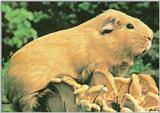
As far as small pets go, guinea pigs are among the easiest to care for, and also rate high on the cuddliness scale. You will need to feed them and check their water daily, and change their bedding about once or twice a week -- somewhat less when they are small. Also, if they are confined to a cage, they need to be allowed to run around a larger area for exercise daily.

A guinea pig's main diet should consist of dried meadow hay supplemented by pellets or crushed oats and fresh vegetables. If meadow hay is not feasible, a legume hay such as clover may be substituted. Whichever hay you use should be available at all times. If you are concerned about your guinea pig becoming obese you should probably limit pellets to a small amount per day They should also get a cup or two of fresh vegetables daily---aim for ones with high vitamin C, which guinea pigs need to keep healthy. Avoid iceberg lettuce (the pale lettuce that comes in heads ), since it has next to no nutritional value Other than that, most fresh vegetables and fruits that are safe for humans are safe for guinea pigs.
Any kind of cage with a solid bottom is okay. As for size, a rule of thumb is a minimum of two square feet per guinea pig. If they are not allowed to run around for exercise on a more or less daily basis, they will need more space to be happy and healthy. The main thing to remember about housing cavies is that these little animals need to keep dry. Damp conditions combined with cold soon bring on illnesses such as pneumonia and this results in an early death. Cavies can cope with cold conditions as long as they remain dry and have plenty of bedding material to snuggle into.
There is considerable evidence that cedar based bedding is harmful to small animals. Pine shavings are fine,also there are several alternanative beddings to use, made of aspen or recycled paper. Many pet stores carry aspen shavings, and you can ask your vet or local pet store to order other beddings for you to try out.
Yes, you will probably need to trim your guinea pig's toenails, unless he or she does a lot of running around on bricks or concrete or other rough surfaces that will keep the nails short. Once the nails start getting long there is nothing but you clipping them to remedy the situation; the nails will eventually either curl back into the pad of the foot, crippling the guinea pig, or else break off and sometimes cause bleeding and infections in the process. You can clip the nails at home yourself or, if you feel insecure about it, you can have a vet do it the first time so you can see how it's done---although they may charge you a fair bit for this. You can use either a normal human nail clipper or the clippers with curved blades they sell in pet stores for trimming cat nails. The easiest way to do this is to have a friend help you, so that one of you can hold the guinea pig while the other trims the nails. If this isn't possible, some people recommend rolling your guinea pig up in a blanket or something, so he (or she) can't see and doesn't struggle, and turning him on his back in your lap so his face is still covered but his feet stick out. I've never tried this myself, so I don't know the precise logistics of it, but apparently it keeps them from putting up a fuss. The thing you have to be careful of is not to cut the quick, which is the pink part in guinea pigs.
It's normal for a guinea pig to be afraid of you at first, and some guinea pigs, depending on personality, are always a little shy. However, with patience and love, you can almost always make good friends with a guinea pig. The younger they are when you start, the easier it will be to gain their trust.
Good luck with your new pet!